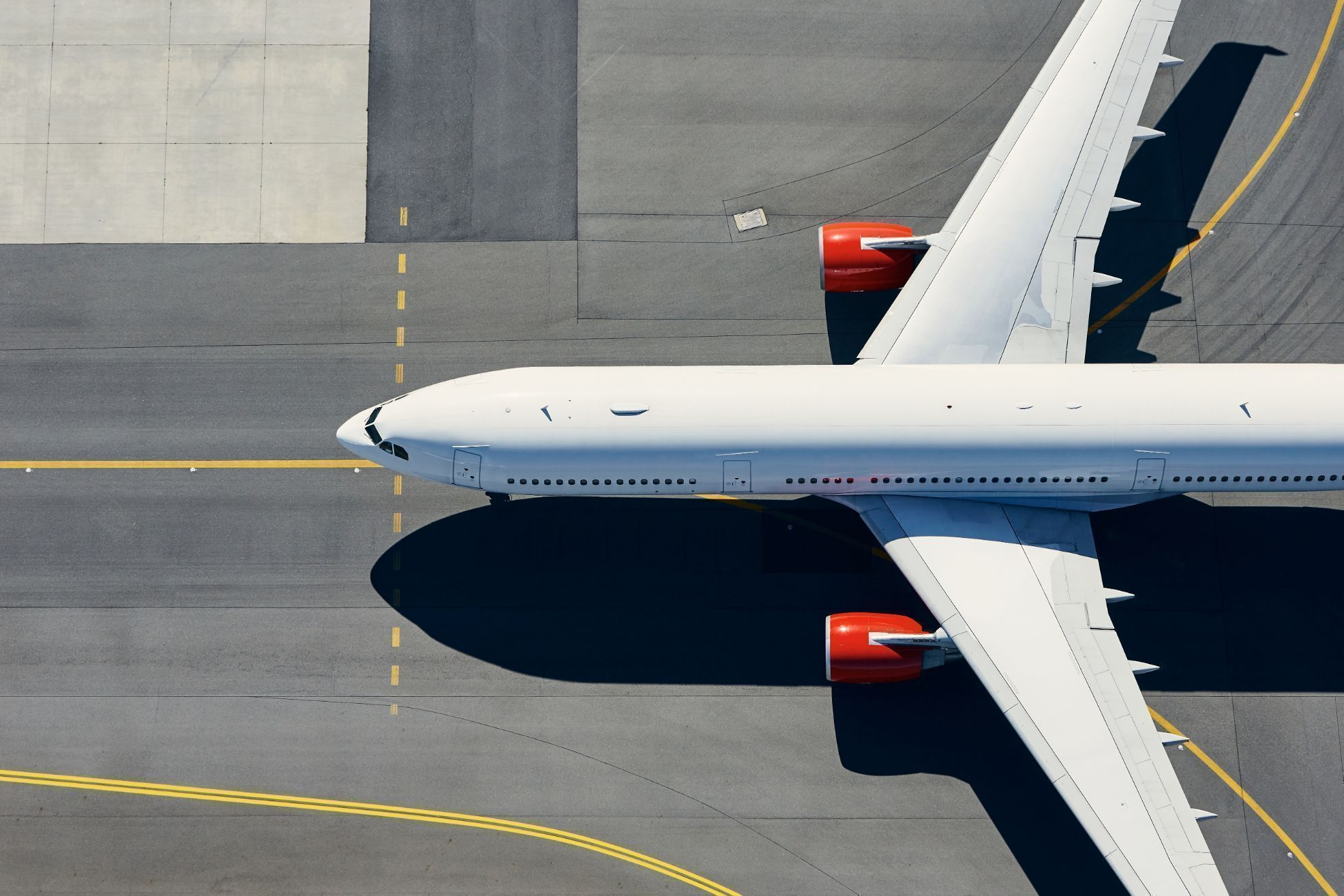The ongoing airport projects in India, which comprise the country’s largest airport and expansions for several busy existing sites, have a combined value exceeding $15 billion.
According to Global Data’s construction database, the aviation sector in India is experiencing rapid growth and is currently ranked as the world’s fastest-growing industry. Furthermore, in terms of passenger volume, it is estimated to be the third largest globally.
Notably, India possesses the second most valuable airport construction project pipeline in Asia, trailing only China. Furthermore, it holds the distinction of having the most valuable pipeline in South Asia, with a total worth exceeding $32 billion.
The airport construction project pipeline in India boasts an impressive value of over $32 billion, making it the most valuable in South Asia and the second most valuable in all of Asia, just behind China.
10: Upgrading Chennai International Airport, Chennai: Rs28bn

The first project among the top ten involves Chennai International Airport, which is the 5th busiest airport in India and one of the country’s oldest, with a history dating back to 1930. Owned by the Airports Authority of India, the airport features two runways and three terminals. Recently, the first stage of construction for a new integrated terminal was completed in April 2023.
Once the second stage is finished, the new integrated terminal will replace the existing older terminals 2 and 3, significantly increasing the airport’s capacity to accommodate up to 23 million passengers annually. Although plans were initially in place for the construction of a third runway, they were put on hold due to the proposal for a new greenfield airport in nearby Parandur.
Furthermore, apart from passenger-focused expansions, a new integrated cargo terminal will be built, resulting in an expansion of the airport’s cargo area from 35,920m² to 54,620m². The entire project is anticipated to reach completion by the end of 2024.
9:Expansion of Mysore Airport Runway, Mysore: (Rs34bn)
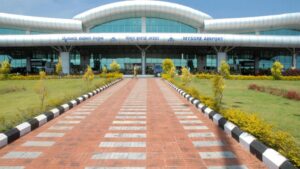
Mysore Airport has a historical background dating back to the 1940s when it was constructed under the Kingdom of Mysore. However, the current terminal commenced operations in 2010, although due to a lack of passenger response, flights were discontinued until the Indian government initiated its regional airport scheme.
To accommodate larger jet aircraft such as the Boeing 737 and Airbus A320, the runway at Mysore Airport is undergoing expansion. The plan involves extending the runway from its current length of 1,740m to 2,750m, and eventually to 2,795m. However, the second extension has encountered challenges due to the presence of a railway line at the west end and a national highway at the east end, necessitating diversion.
While the existing terminal at Mysore Airport can only accommodate 200 passengers at a time, or approximately 190,000 annually, the runway expansion has prompted the government to upgrade Mysore to an international airport. The entire project is expected to be completed by 2027.
8: Bhogapuram Greenfield International Airport, Vizianagaram: Rs49bn
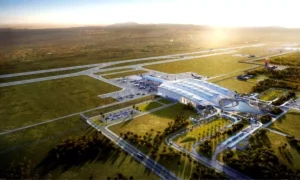
The Bhogapuram Airport, also known as GMR Visakhapatnam International Airport, is the first entirely new airport development within the top ten projects. Construction began in May 2023 and is slated for completion in early 2025.
Spanning an expansive area of 2,203 acres, the airport will feature one terminal and a 3,800m long runway. In Phase 1, it is expected to handle 6 million passengers annually, with a projected capacity of 18 million passengers per year in Phase 3.
The project is a joint effort between GMR Group, Andhra Pradesh Airports Development Corporation (APADCL), and the government of Andhra Pradesh, operating under a public-private partnership model. Furthermore, APADCL has entered into a memorandum of understanding with the Indian Navy, which has agreed to relocate the existing Visakhapatnam Airport civil enclave to Bhogapuram.
7:Expansion of Rajiv Gandhi International Airport, Hyderabad: (Rs57bn)
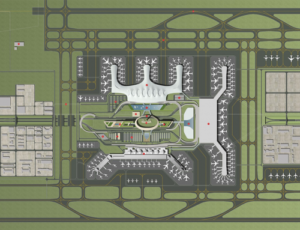
Rajiv Gandhi International Airport, India’s first greenfield airport developed through a public-private partnership, has been operational since 2008 and ranks as the country’s fourth busiest airport. It currently serves approximately 20 million passengers annually.
To accommodate growing passenger demand, the airport is undergoing an expansion project that will enhance its capacity to handle up to 30 million passengers. The expansion is being carried out by Larsen and Toubro and Megawide Construction Corporation on behalf of the majority owner, GMR Group. The project is expected to reach completion later in 2023.
Rajiv Gandhi International Airport features two runways and a spacious integrated passenger terminal, which has undergone expansion during the recent construction works. Additionally, the airport has increased its number of parking bays from 57 to 83, providing improved facilities for aircraft parking and operations.
6: Lalitpur Airport Development, Lalitpur: (Rs82bn)

The Lalitpur Airport development project aims to revive an airstrip that was originally constructed during the Second World War but has remained unused since then.
Despite previous proposals, the Uttar Pradesh government approved the development of the site in March 2021. Initially, the airport will cater to smaller domestic aircraft, but there is hope that it may eventually evolve into an international destination.
Owned by the Airports Authority of India, the Lalitpur Airport site will encompass approximately 90 hectares of land. This development is expected to have a positive impact on the Bundelkhand region by becoming its fourth airport and contributing to its growth and connectivity.
5: Expansion of Indira Gandhi International Airport, Delhi: (Rs115bn)
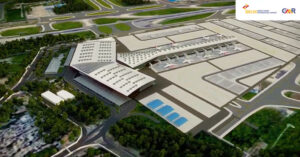
Indira Gandhi International Airport, presently the busiest airport in India and the ninth busiest globally, has recently expanded its capacity to accommodate even more passengers. In 2022, a staggering 65 million passengers traveled through the airport’s three terminals.
The expansion project, overseen by the airport’s owner, GMR Group, is nearing completion. The third terminal was inaugurated in 2010, and an additional cargo terminal has been constructed. Moreover, a fourth parallel runway is expected to be finalized by September 2023.
To alleviate traffic congestion and cater to the growing demand, another airport called Noida International Airport is also under construction in the vicinity of Indira Gandhi International Airport. This development aims to ease the burden on the existing airport and enhance overall air transportation in the area.
4: Expansion of Kempegowda International Airport, Bengaluru: (Rs156bn)
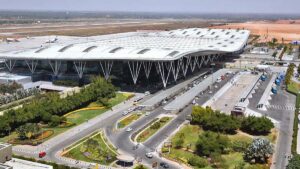
Kempegowda International Airport, which first opened in 2008, has become India’s third busiest airport and continues to grow. The airport currently operates with a second terminal, and plans are underway to construct a third terminal and a third runway in the coming decade.
Terminal 2 of Kempegowda International Airport commenced operations in January of this year. Once the second phase of expansion is completed, the airport’s passenger handling capacity will increase to 55 million passengers annually. Additionally, Terminal 2 will soon handle all international operations.
Bangalore International Airport, the operator of Kempegowda International Airport, is primarily owned by Fairfax India Holdings, with Unisys Corp serving as the management contractor for the construction of the second terminal. The airport’s development reflects the growing demand and significance of air travel in the region.
3: Navi Mumbai International Airport, Mumbai:(Rs189bn)

The Navi Mumbai International Airport is a new addition to Mumbai’s infrastructure, serving as the second airport in the metropolitan region alongside the existing Chhatrapati Shivaji Maharaj International Airport, which ranks as the second busiest airport in India.
Spanning a vast area of 1,160 hectares, the Navi Mumbai International Airport will comprise three passenger terminals, a domestic and international cargo terminal, and two runways. In its initial phase of construction, set to be completed in 2025, the airport will have the capacity to handle 25 million passengers annually. Upon full expansion after the third phase, it is expected to accommodate up to 90 million passengers each year.
The construction of the Navi Mumbai International Airport is a collaborative effort involving the City and Industrial Development Corporation and Adani Airports Holdings Limited. Furthermore, the airport is an integral part of the plans for the proposed Mumbai-Hyderabad high-speed rail line, with the airport serving as a terminal station for the rail line.
2: Expansion of Sardar Vallabhbhai Patel International Airport, Ahmedabad:(Rs197bn)
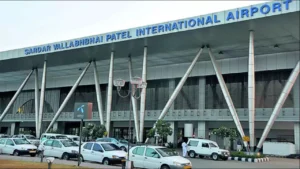
A significant expansion is underway at Sardar Vallabhbhai Patel International Airport to address the surge in passenger numbers. The expansion plan includes the addition of a third passenger terminal and a new cargo terminal at the airport’s site.
Construction on this project began in mid-2022 and is scheduled for completion in 2026. Suroj Buildcon Pvt. has been appointed as the construction contractor by Adani Airport Holdings, the parent company of the airport.
Considering the limited space available at the Ahmedabad airport site, the Airports Authority of India has plans to construct another airport in the nearby city of Dholera. This additional airport aims to alleviate congestion at Sardar Vallabhbhai Patel International Airport, as it is expected to remain busy even after the expansion project is finished.
1: Noida International Airport, Jewar:(Rs345bn)

The Noida International Airport, also referred to as Jewar International Airport is the largest ongoing airport project in India. Groundbreaking for the airport took place in 2021, and it is anticipated to be fully completed by 2040. The development is being undertaken by Yamuna International Airport Private Limited, a subsidiary of Zurich Airport International AG.
This massive undertaking involves the construction of two initial runways, with a projected capacity to handle 12 million passengers annually by 2024. Over the next three decades, the airport will gradually expand to encompass six runways, accommodating a remarkable 60 to 120 million passengers per year. Upon completion, it will become the largest airport in India and Asia and the fourth largest worldwide.
The primary objective of the Noida International Airport is to improve connectivity between Noida, Western Uttar Pradesh, Delhi, and the National Capital Region by alleviating the high traffic congestion experienced at Delhi’s Indira Gandhi International Airport. Additionally, Noida International Airport has ambitious plans to become India’s first net-zero airport, demonstrating a commitment to environmental sustainability.

